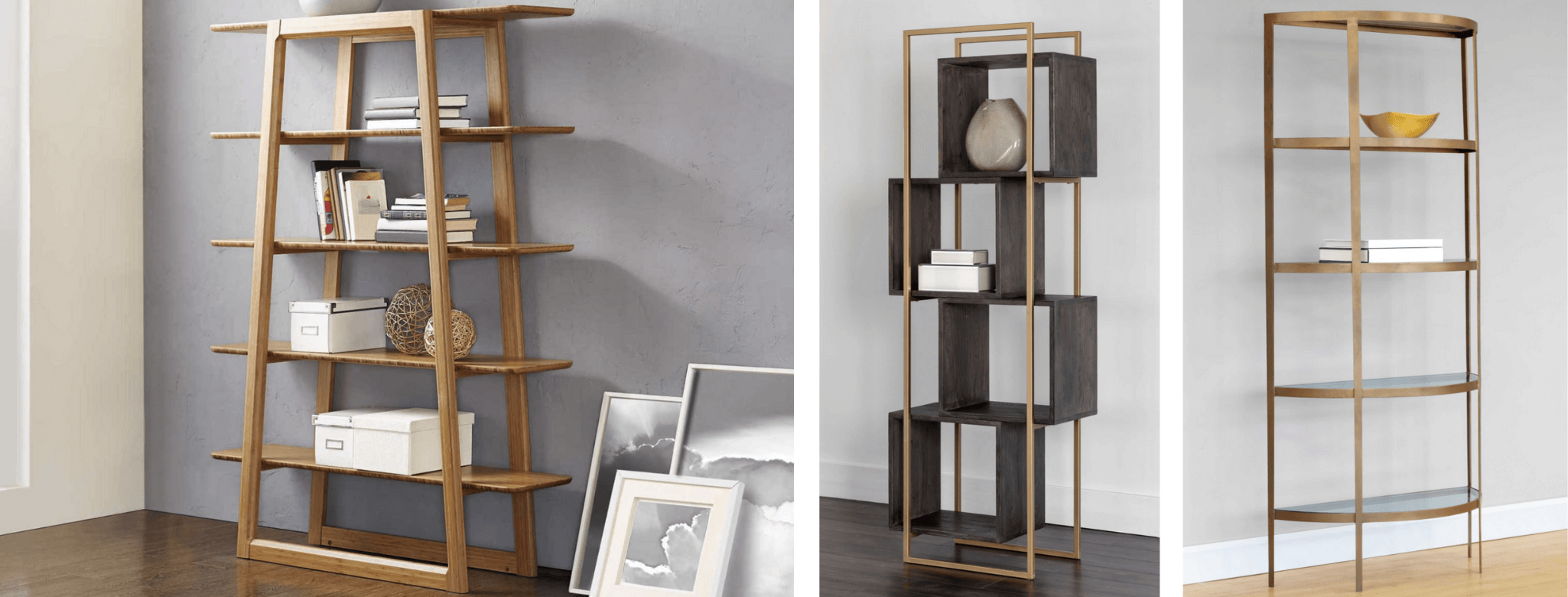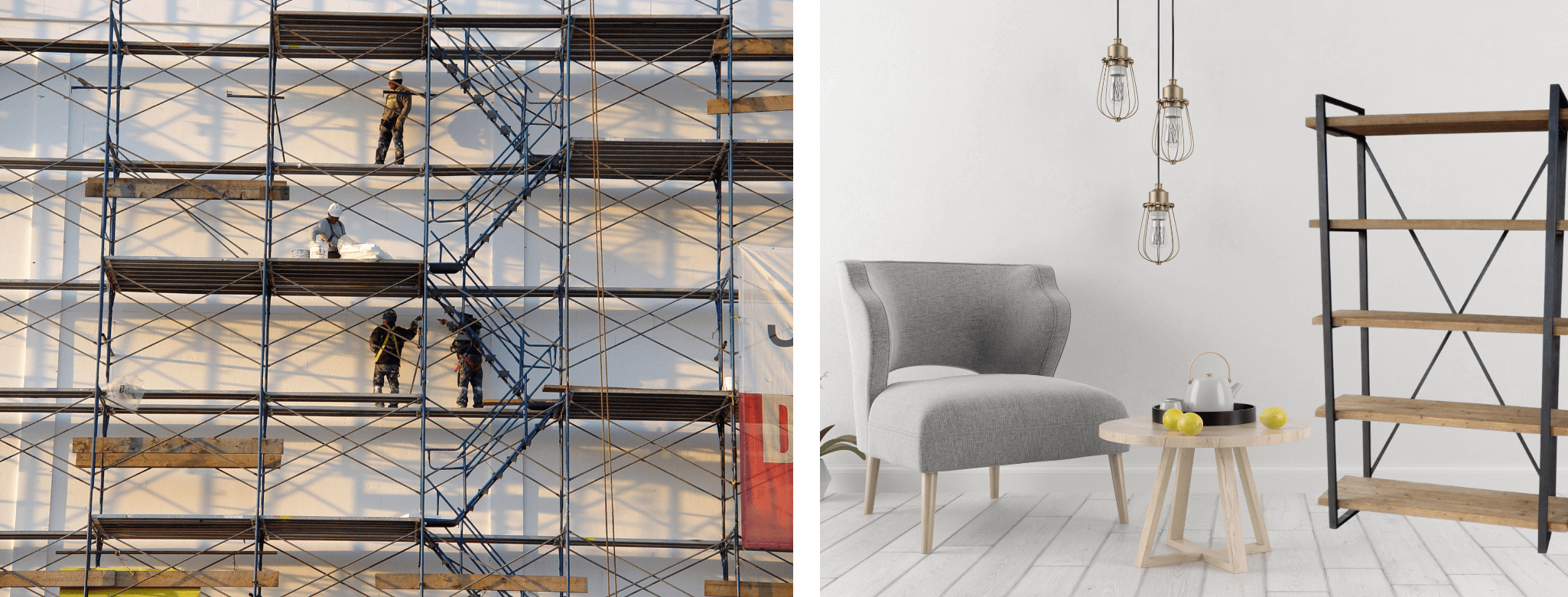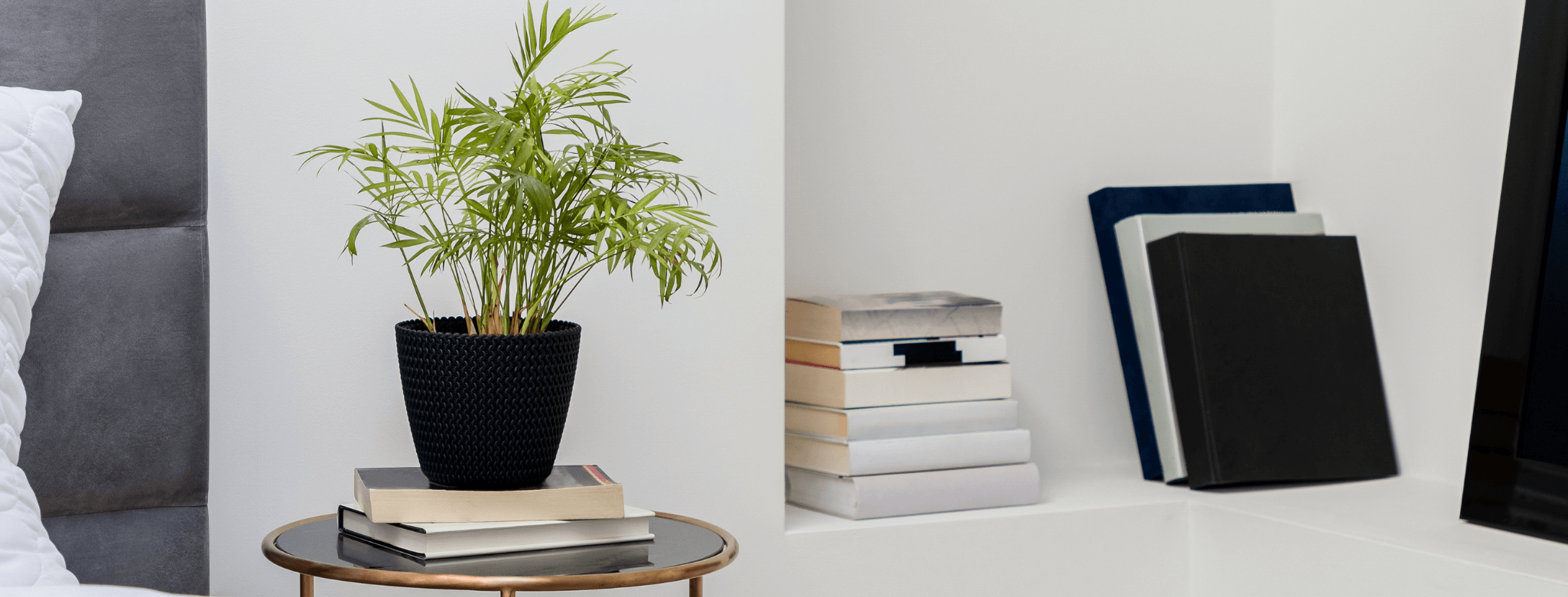


(Left) Gus* Modern Branch Bookcase and (Right) Unique Furniture Stavanger Grey Bookcase
The styles, sizes, materials, finishes and accents of bookcases and shelving units for the home vary widely — far more widely than one might imagine. Styles might be delicate and antique-inspired like the étagère bookshelf or might be heavy and industrial like the scaffold bookshelf. Size-wise, a bookcase might be short and stout like a console bookcase or might be tall and skinny like a corner bookcase. Some are enormous and unusual — as is common of custom-designed built-ins — while others are perfect for small spaces. Accents, materials and finishes also abound, with some bookcases made from traditional materials like wood and metal while others are made from glass, acrylic and MDF. Bookcases might rest squarely on the floor, on a tripod or on exquisite brass ferruled feet. To learn more about the many types of bookshelves and how to choose a bookcase for your home, follow below!

Built-in bookcases are those — you guessed it! — built into the wall of a home. They often trace the architectural details of a space, sometimes following the lines of a doorway or the angles of a pitched ceiling. Because of this, built-ins are some of the most commonly customized bookshelves and are beloved because — despite their large size — they take up less space than freestanding shelving units. Writers at Sebring Design elaborate in their article “35 BUILT-IN BOOKSHELVES DESIGN IDEAS,” noting that “built in bookshelves provide the chance to blend highly functional storage with a personal and unique design statement.” Katherine Pushkar agrees in her article “7 Surprising Built-In Bookcase Designs” for This Old House, writing that built-in bookshelves are “made to rise ceiling high, create an alcove for furniture, or wrap an existing nook.”
Designed for a particular home — and with the homeowner’s particular style in mind — “they can add style, charm, and architecture to an interior, all while offering custom storage and display space.” As Pushkar explains, designs of built-in bookshelves vary widely and include everything from library-style shelving to those accented with bench seating. Some are curved or peaked at the top, ideal for attics and arched ceilings, while others include closing doors — perfect for an unusual headboard. Built-in bookshelves are typically made from materials similar to those used in building the home itself. They are often painted or stained to blend in with the color of the surrounding wall.

(Left) Greenington Currant 47'' x 62'' Caramelized Bookshelf (Center) Sunpan Modern Home Brown / Gold Bookcase (Right) Sunpan Modern Home Gold Bookcase
Etagere bookcases are typically intended for display rather than for pure function — e.g. storing an entire collection of heavy encyclopedias. The open-shelved, transparent-backed units often feature delicate pieces like ceramic vases, framed photos and other decor and arts elements. They are more commonly made of glass, non-industrial metals and acrylic than they are of wood or industrial metals like stainless steel or aluminum. As Mel Studach writes in the article “” for Architectural Digest, “the étagère surfaced among French aristocrats in the late 18th century.” It was from these French étagères that other popular styles emerged across Europe, including the corner bookshelf and the A-frame bookshelf. Specifically, the “whatnot” bookshelf — a cross between a bookcase and a hutch or cabinet — “gained popularity in Europe soon” after the étagère arrived on the scene in France. According to the Antiques World article “What is an Antique Whatnot?,” whatnots are the common version of étagère, more often found in regular homes than in palaces and châteaux.
The antique whatnot inspired many of the mid-century modern bookcases, which feature a mixture of functional shelving, open shelving and closed drawers. As the article explains, like étagères, the “whatnot stand was intended to display a variety of objects, ornaments, curiosities, books and papers.” Unlike étagères, however, whatnots were more functional, made of “mahogany, rosewood or walnut” and able to accommodate more substantial items. Hallmarked by a “simpler rectangular shape, three shelves and occasionally one or two drawers below,” whatnots were thin, tall and perfect for small spaces. It was from the whatnot that the contemporary s-shaped bookcase arose. For a modern A-Framed étagère, we love the Greenington Currant 47'' x 62'' Caramelized Bookshelf from TopModern. If one prefers a more delicate, classical style — with its glass shelves and brass frame — we love the Sunpan Modern Home Gold Bookcase.

(Right) Moe's Home Collection Lex Bookcase
Scaffold bookshelves are exactly what they sound like. Often featuring a frame made from an industrial-looking metal — with shelves to match — scaffold bookshelves resemble construction scaffolding. Kaitlin Madden explains the unusual style in her recent article for MyMove. She writes that scaffold bookcases are “fashioned from shelving suspended between two ladder-like supports.” One might see a scaffold bookshelf paired with a rustic table accented by hairpin legs or with other industrial interior elements like wire or hammered brass pendant lights and concrete planters. Reclaimed wood and iron are two materials commonly featured in scaffold bookshelves. For instance, the Moe's Home Collection Lex Bookcase from TopModern boasts solid fir wood and iron, both with a distressed finish.

Corner bookshelves require little explanation. They are typically triangular or semi-circle shaped, with the curved or tipped side set into the corner of a room. Corner bookshelves are a favorite of small-space interior designers and of apartment dwellers, as they take up very little square-footage. Corner bookshelves are typically open-ended, open-backed and multi-tiered. Many feature a hutch or drawer element for extra storage. The frontward-facing portion of a corner bookshelf may either be straight or curved and the entire unit may either rest on the floor or be elevated on three feet. Like étagère bookshelves, corner bookshelves are often best suited to lightweight collectibles and decor objects rather than heavy books. The 21Oak writing team explains this further in their article “The best corner bookshelves to show off your favorite books and knickknacks.” The best corner bookshelves for small spaces — according to the article — are those lifted “off the floor and mounted on a wall to appear [as though they are] floating.”

(Right) Copeland Furniture Sarah Bookcase
Traditional or standard bookshelves typically look like tall rectangular boxes. They rarely have feet or legs, are usually constructed from wood and often feature a closed backing. Traditional bookcases include the barrister style — a tall unit made from carved wood featuring evenly spaced shelving, occasionally with glass doors. These types of bookcases are commonly found in both home and corporate office spaces as they can house a number of heavy books without incident, making the style one of the most dependable. Cubby and modular bookcases often resemble traditional or standard bookcases, but rarely feature backings and/or unfinished wood construction.

(Left) Gus* Modern Branch Ash Black Bookcase and (Right) Gus* Modern Branch Ash Black / Blonde Bookcase
Leaning and/or ladder bookshelves are a trendy option, perfect for small space houses and apartments and ideal for minimalist and industrial-inspired interiors. Some leaning and/or ladder bookshelves can be mounted to the wall, adding extra security, while others must be provided with a support but are freestanding. Thin and lightweight, ladder and leaning bookshelves are commonly used in non-work spaces such as entryways, bedrooms, laundry rooms and bathrooms to house items other than heavy books. Our favorites include a couple from the Gus* Modern Branch Collection, all of which can be mounted to the wall and one of which is modular.

(Left) Sunpan Modern Home Mixt Brown / Antique Brass Bookcase, (Center) Kartell Ghost Buster Transparent Crystal Bookcase (Right) District Eight Hard Fumed / Black Bookcase
Bookshelves intended for residential interiors are typically made from wood, MDF, acrylic, glass, iron, brass, aluminum and/or a mixture of several of these materials. Bookshelf types focused on functionality — e.g. the standard, cubby and modular varieties — usually feature a single material like plastic, wood or MDF. Conversely, display-focused bookcases — like those of étagère, A-frame and corner styles — often feature mixed media and may include some hardware and accents made of brass, ceramic and/or glass. Bookshelves made from MDF and acrylic are often coated and/or painted. Footed bookshelves — like hutch and some A-frame units — may be outfitted with brass ferrules.
Our favorite mixed media bookshelves from TopModern include the District Eight Hard Fumed / Black Bookcase and the Sunpan Modern Home Mixt Brown / Antique Brass Bookcase. The District Eight bookcase features a solid oak frame, three large solid oak shelves with soft edges and a black-stained solid and veneer oak cabinet with sliding door. Its feet provide a vintage vibe, with their steel legs and wooden fittings. The Sunpan bookcase resembles an antique screen with its interlocking geometric panes. We also love the contrasting finishes of the brass-toned iron and acacia wood veneer.
Bookshelves range significantly size-wise. The height of the overall shelving unit as well as the height of individual shelves varies. So too do the width of the unit and the width of each cubby or shelf. Choosing the right size bookshelf for your home will depend on your expected functionality for the unit, where the unit will be placed, what will be stored in the unit and which types of activity may occur around the case itself. For instance, a bookcase that does not protrude much from the wall — perhaps solely the depth of a typical book — would likely be best for an alcove or hallway.
According to custom furniture and cabinetry company Brezlin in their “Shelf Design Guidelines,” functional bookshelves should prioritize “ease of shelf access,” while decorative bookshelves can be slightly taller than the average person’s reach. The company notes that “for ease of shelf access, bookcases are generally no higher than 84 inches (2.13 m) [while] small bookcases are usually 30 to 42 inches (1.07 m) high.” According to the guidelines, “the highest shelf in a bookcase should be as high as an average-sized person can comfortably reach - about 72 to 78 inches (ca. 2 m).”



